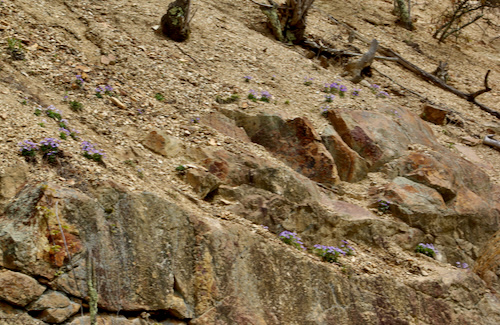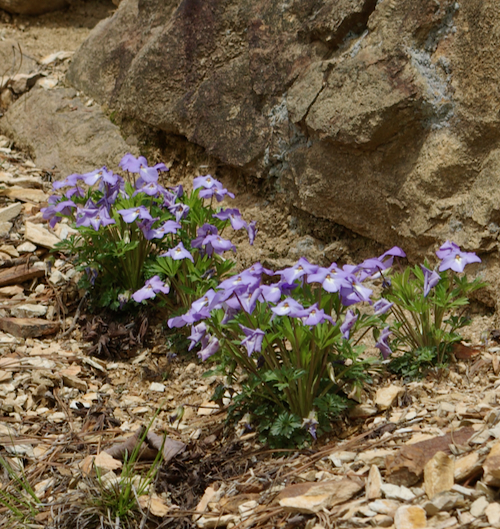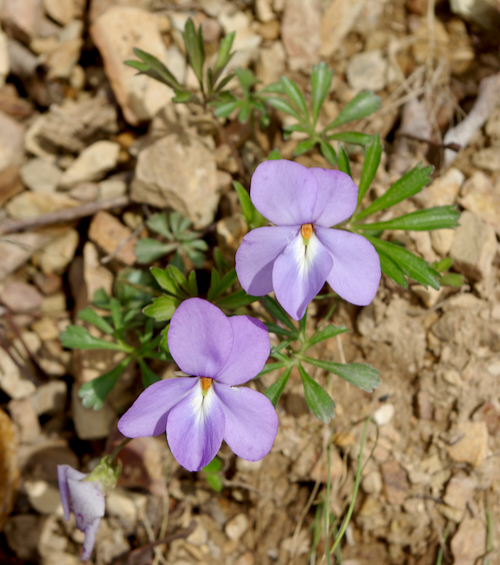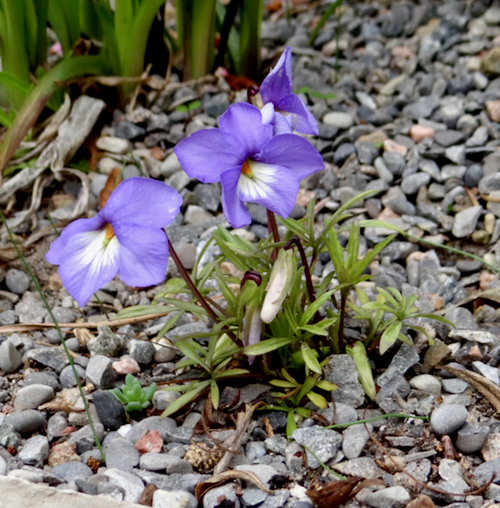
Plant of the Month May 2024
GENERAL INFORMATION: Each year, in the past, NARGS hosted Eastern Winter Study Weekends, usually in February. Annual Meetings were also frequently in driving distance. ORGS members would get a group together and drive down, often puzzling border officials. Four unrelated people, all newish Canadians.
I first saw Viola pedata, flourishing on the banks of the Interstate. (We stopped.) These were the most beautiful violets I had ever seen! Plants never seemed to be for sale and seed would not germinate.
I eventually grew some plants which did not last. I need acid sand!

Viola pedata growing beside the Blue Ridge Parkway.
Varieties: Viola pedata var. concolor (upper 2 petals darker), Viola pedata var. lineariloba (petals all same colour).
Selections: Viola pedata ‘Eco Artist Palette’ - upper 2 petals dark purple.
Common Name: Bird’s-foot Violet, Mountain Pansy.
Range: Native to Eastern USA and endangered in SW Ontario.
Habitat: Roadsides, dry, sandy, rocky, or clayey banks and open woods.

Viola pedata in wild, close up.
Life Cycle: Herbaceous, stalkless perennial with a non-stoloniferous rhizome.
Height: 7-15 cm.
Bloom Time: Mid May - mid June. Occasionally again in early fall.
Flower Colour & Size: Single flowers, to 4 cm wide, with five lilac-purple petals, not typical violet-shaped. The two upper petals may be darker in colour. Orange stamens.

Viola pedata flowers.
Fruit: Non cleistogamous (automatic self pollination) like many violets so two plants are needed to produce a green seed capsule. Sticky sugary seeds are ejected and carried away by ants.
Leaves: Grey-green. Each of the three main lobes are further divided into narrow segments, like a bird’s foot.
CULTIVATION:
Light: Full sun.
Soil: Well drained, acidic soil. Dislikes rich, organic soils.

Viola pedata in scree bed, showing flowers and leaves.
Water: Dry to medium moisture.
USDA Hardiness: Zones 4-8.
Companion planting: Dislikes competition so grow away from other rock garden plants.
Propagation: by seed. Fresh is best. Sow at 20°C for 6 weeks, then place @ 4°C for 6 weeks, then slowly raise temperature to 10°C for 6 weeks. If there is no germination, repeat the cycle. Try root cuttings.
Pollinators: Bees, Butterflies. Larval food source for the Regal Fritillary, now at risk.
Problems: Usually none, unless poor drainage.
References:
https://www.ontario.ca>page>birds-foot-violet
https://onrockgarden.com/index.php/germination-guide
Ladybird Johnson Wildflower Centre
Text and images supplied by Anna Leggatt (Toronto Master Gardener)
